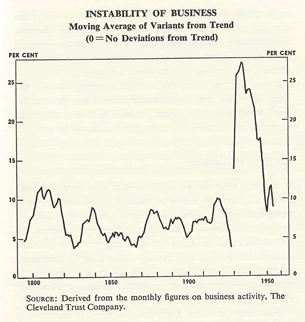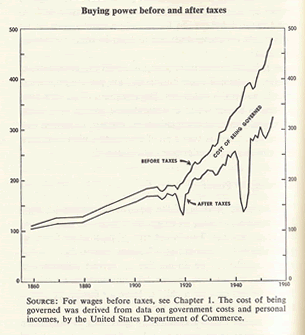At a talk this Fall, Charles Koch mentioned that the book Why Wages Rise by F.A. Harper was an influential book in his career. Curious of the subject and the inspirations of such a successful man, I decided I best read it myself.
It was fascinating to see that the book did not begin with much framing and jumped right into the discussion with a focus on labor unions and the misperception that their demands lead to a rise in wages. This says a lot about who Harper was trying to communicate these ideas to and places the stage of development of the US economy at the time the book was written, in 1957.
Harper draws a nice analogy to explain why it can be harmful to simply raise workers wages without a commensurate increase in productivity:
⇥ During 1955, the average pay of an employee of GM was $5,011. Yet GM's profits for the year were $1,189,477,082 (or $3,751,477,082 before any ascertainable taxes) on a total business of $12,433,277,420. It can be seen at a glance that doubling the pay of this employee would be no more noticeable in the whole enterprise than would be the adding of another automobile to those owned in the State of Michigan.
⇥⇥
Doubling the pay of all GM employees, however, would be quite a different story. It would eat up in one year more than the total value of the firm's real estate, plants, and equipment.
He continues to explain how productivity is the true source of real wage increases and how inflation can harm wages. He emphasizes the role a sound currency play when considering wages:
When you accept money in trade, you are proceeding on faith in it as a sort of implied contract. The implied contract is this: When you trade something for money as an intermediate step to getting what you eventually want in exchange, you are operating on the assumption that the money will serve your intent rather than thwart it.
Harper's broad approach to understanding the forces which influence wages is commendable. I truly enjoyed Harper's use of images throughout the book to complement his main points. Here are a few of my favorites:
The Business Cycle

The eloquence of this graph captures the fluctuation of the economy as a force that is always present rather than a cycle that fluctuates around some sort of equilibrium, as the business cycle is often depicted.
Buying Power

What I particularly like about this graph is how it labels the section in between the citizens buying power before taxes, and the citizens buying power after taxes. The section is labeled: The Cost of Being Governed. I find the language eye opening in a small way. Most of the costs that we have in our life we try to find a way to reduce. Increased productivity involves identifying better ways to do things and then changing our ways accordingly, freeing up more time to invest in other ways or for leisure in the process. By framing the data in such a way, it suggests that governance has a specific role in the economy and leaves the hope that: if we can improve the ways in which we currently govern our society, we can reduce our necessity of this governance, freeing up more time to invest in other ways or for leisure across the society. A very nice way to put it.